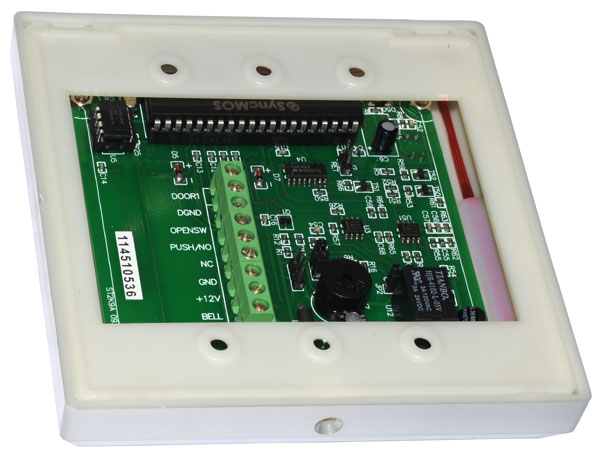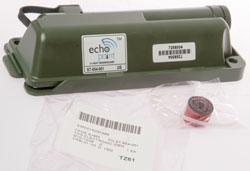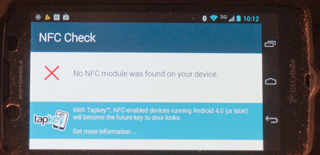


Fig 1
MG236B RFID Controller Front Panel |
Fig 2
MG236B RFID Controller Back Panel |
Fig 3
MG236B RFID Tag |
This is not a passive RF ID tag, but rather an active
transponder, similar in concept to the FasTrak
tool bridge unit. It's designed to be used in situations where
there are many similar transponders nearby, i.e. in a network of
transponders, like a warehouse.
There is a user replaceable LS 17500 3.6V battery.
Tx: 433.92 MHz, FSK dev +/- 50 kHz, 27.8 kbps, 300 meter range
Rx: 123 kHz, ASK On-Off Keying, 1.6 Kbps 50% duty cycle, Range:
4' or 12' depending on the Savi reader being used
5640151
Communication system for
communicating with tags, Texas
Instruments Incorporated, Jun 17, 1997
5686902 Communication system for communicating
with tags, Texas
Instruments Incorporated, Nov 11, 1997
The FCC has: Photos, Installation
Guide,
Fig 1 |
Fig 2 FCC ID: KL7-654T-V2 IC: 2404A-654T1  |
Fig 3 Serial port to allow programing the
internal memory |
NFC is another name for an RFID that can be activated using a
13.56 MHz CW signal. There is a problem in that every time
the NFC gets enough power it will send it's message.
This means someone can have a transmitter in a backpack, briefcase
or in their clothes and if they can get close to you read your NFC
data. If you're using your NFC like a credit card then they
are capturing your credit card information. There are
"Wallets" that block the CW signal and/or the signal from the
credit card to prevent this abuse, but they are not a solution for
a cell phone since blocking it's NFC capability probably also
would keep it from receiving incoming calls.
I learned about this in relation to Google Cardboard (Official web page,
YouTube Intro) where they use an NFC tag to configure the phone
for virtual reality in landscape, turn off the information bars
and maybe start a VR app.
My Motorola
Electrify 2 (XT881) does not have NFC.

Also see NFC on my Cell Phone web page.
2607004 Radio transmission system, Donald B Harris, 1952-08-12, -
2774060 Detecting means for stolen goods, Thomas F Thompson, (Belford, Oliver & Thompson), 1956-12-11, - detects resonant tag
2927321 Radio transmission systems with modulatable passive responder, Donald B Harris, 1960-03-01, -
3054100 Signalling system, Clarence S Jones, General Precision, 1962-09-11, - active RF-ID, for railroad cars, RF triggers tag which responds with a number of frequencies which is the data.
3163860 Object identification system, Francis M Bailey, GE, 1964-12-29, - for freight cars - requires power at the freight car, but the principle is the same as modern RFID.
3169242 Identification interrogating system, Richard K Davis, Francis M Bailey, GE, 1965-02-09, - passive, for railroad cars, 8 fixed resonators in the range 510 to 600 kHz
3299424 Interrogator-responder identification system, Jorgen P Vinding, 1967-01-17, - inductive coupling of power to tag, VHF reply frequency, shift register for data in tag
3373425 Tunnel diode circuit utilized to control the reply of a passive transponder, Erwin E Barischoff, 1968-03-12, - passive RF-ID, but with no data, so limited use.
3438489 Automatic sorting system for articles such as mailbags, Michel J Cambornac, Jean J Chazot, Lucien P Puechberty, Mixte pour L Etude, 1969-04-15, - tag responds with 9 bit code, aimed at mail bags
3493955 Method and apparatus for detecting the unauthorized movement of articles, Arthur J Minasy, Monere Corp, 1970-02-03, -
3500373 Method and apparatus for article theft detection, Arthur J Minasy, (NoGo Corp) 1970-03-10, - 1 MHz carrier is swept over 500 Hz and detects a resonant tank in the tag. single resonant circuit in tag.
3624631 Pilferage control system, Marc Chomet, Donald E Ellison, Robert F Watterson, Sanders Associates (Lockheed), -single resonant circuit & fusible link,
3628267 Label attachment, Arthur J Minasy, 1971-12-21, -
3678608 Label attachment means, Arthur J Minasy, Knogo Corp, 1972-07-25, -
3696379 Apparatus for article theft detection, Arthur J Minasy, Knogo Corp, 1972-10-03, -
3706094 Electronic surveillance system, Peter Harold Cole, Richard Vaughan, 1972-12-12, -
3713148 Transponder apparatus and system, M Cardullo, W Parks, Communications Services Corp, 1973-01-23, - modern RFID that can have complex responses, cited by 185 patents - for toll collection
3723967 Induction-keyed door-lock and power control circuit for automotive vehicles and the like, C Atkins, P Carlson, Wagner Electric (Cooper Ind), 1973-03-27, - car door lock
3750167 Postal tracking system, J GehmanG Herlich, S Mikuteit, General Dynamics, 1973-07-31, - passive RF-ID. 900 MHz to power the tag.
3752960 Electronic identification & recognition system, C Walton, 1973-08-14, - multiple tank circuits, cited by 74 patents
3810147 Electronic security system, G Lichtblau, Checkpoint Systems Inc, 1974-05-07, -
3831112 Voltage controlled sweep oscillator, C Walton, Proximity Devices, 1974-08-20, -
3832530 Object identifying apparatus, H Reitboeck, T Brody, Westinghouse (CBS), 1974-08-27, - mail bag tag 6x9 matrix code
3842324 Induction-keyed control circuit with keying network having variable resonant frequency, C Atkins, Wagner Electric, 1974-10-15, - Varactor diode
3895368 Surveillance system and method utilizing both electrostatic and electromagnetic fields, Lloyd L Gordon, Robert D Williamson, Sensormatic Electronics Corp, 1975-07-15, -
3970824 Electronic recognition and identification system for identifying a family of codes, Charles A. Walton, Robert D. Kohle, David P. Sidlauskas, Schlage Electronics Inc, 1976-07-20, -
4025791 Object identification system, John W. Lennington, Stanley R. Sternberg, Kilo Crop, 1977-05-24, - IR system for parking garage
4047156 Reactively decoupled dual channel keying circuit for wide-band frequency modulated keyable control circuit, Carl E. Atkins, Wagner Electric (Cooper Industries), 1977-09-06, - Tag: 3 coils & 2 caps or 3 caps & 2 coils,
4075632 Interrogation, and detection system, Howard A. Baldwin, Steven W. Depp, Alfred R. Koelle, Robert W. Freyman, DOE, 1978-02-21, - for tracking Nukes (and Cows).
4223830 Identification system, Charles A. Walton, 1980-09-23, -
4326198 Method and apparatus for the promotion of selected harmonic response signals in an article detection system, Eugene B. Novikoff, Knogo Corp (Sentry Technology Corp), 1982-04-20, -
4345253 Passive sensing and encoding transponder, D. Robert Hoover, Identronix, 1982-08-17, - modern RFID tag
4384281 Theft detection apparatus using saturable magnetic targets, Michael N. Cooper, Knogo Corp (Sentry Technology Corp), 1983-05-17, -
4384288 Portable radio frequency emitting identifier, Charles A. Walton, 1983-05-17, - uses the term "RFID". Hotel room key.
4580041 Electronic proximity identification system with simplified low power identifier, Charles A. Walton, 1986-04-01, - tag has digital memory
4623877 Method and apparatus for detection of targets in an interrogation zone, Pierre F. Buckens, Knogo Corp (Sentry Technology Corp), 1986-11-18, - 18 sheets of figures, for books,
5225807 Method and apparatus for sensitizing and desensitizing targets for electronic article surveillance systems, Peter Y. Zhou, Dexing Pang, Knogo Corp, 1993-07-06, - strip in spine of book
5485520 Automatic real-time highway toll collection from moving vehicles, David Chaum, Peter L. Hendrick, Amtech, 1996-01-16, - East coast toll roads E-Zpass,
8078774 Method and system for tracking, Mario W. Cardullo, 2009-08-27, - maybe for shipping containers, rail cars, Etc
bigclivedotcom:Inside a Glasgow Subway RFID train ticket - disposable ticket - Confidex:
8794531 Radio frequency identification tag, Confidex Oy, Priority: 2006-07-13, Pub: 2014-08-05, -
RFID Locks are way too easy to "Hack"! Let me show you!, 11:40 -
Where Did RFID Come From?, 20:00 - Short-Range Radio-Telemetry for Electronic Identification, Using Modulated RF Backscatter, Koelle, Depp, Freyman
FasTrak Vehicle ID Transponder - is an active transponder, not an RF ID tag.
Key, Object & Pet Location Tags -
Spying on Cell (Mobil) Phones
Orion Electronics Ltd. Cellular Base Station ST616-CBS
Phones
Cell Phones
RFIDIOt - hacking toolsBack to Brooke's List of all web pages in alphabetical order, Products for Sale, Electronics, Home page
DEF CON 21 (2013) - RFID Hacking: Live Free or RFID Hard - how to read someone's card without them knowing and making a clone card to gain access to their building.
[an error occurred while processing this directive] page created 13 May 2010.